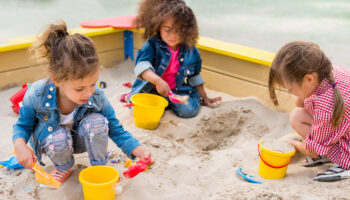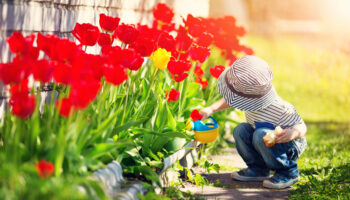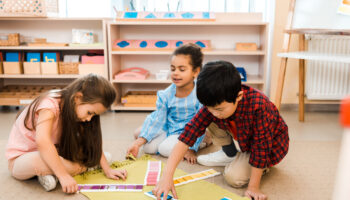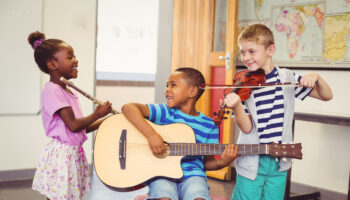Beth Simon
The above is often a response heard from child care providers when asked, “Do you use sand and water play in your classroom?” Although it’s the typical response, it does not mean it’s the developmentally appropriate response. Sand and water play can be messy and is probably the main reason why child care providers have sworn off its use. Don’t swear off sand and water play too quickly, because these materials are cheap or free and offer many benefits to the children who play with it.
Sand and water play are appropriate play materials for older toddlers and preschoolers attending child care centers or in-home child care. Notice I didn’t mention infants and young toddlers and you can probably guess why… this type of play is not recommended for children who are under 18 months of age. They tend to mouth the toys and eat or drink the sand and water, which presents lots of health and safety issues, so this is an activity better left for older toddlers and preschoolers.
Where did you go for your last vacation? Was it the beach? Was it a lake? Was it to one of the many man-made dams or state parks we are blessed with in Pennsylvania? Why do most of us tend to navigate to water and sand when we choose our vacation destinations? It’s relaxing, calming, soothing, and stress relieving. These are also reasons that sand or water play may be an advantage in your classroom. Given proper limitations, defining the rules for play in the sand or water table, or limiting the number of children allowed at the table will help to make this an intentional learning opportunity and not a disruptive center that requires all of your attention. You may even choose to use small plastic bins; shoebox size bins work nicely for individual sand or water play; a large table that takes up a lot of space isn’t required. You may also choose to offer sand and water play outdoors when the weather permits and avoid the mess.
So let’s talk materials. Both sand and water are great materials for developing lots of skills such as hand-eye coordination, fine motor skills, large muscle abilities, social skills, and even math in the right circumstances. Both materials do not have to be present all the time, you could have one or the other, you may limit play to only a certain time of the day, or you could use alternatives or different activities other than sand or water to offer a new experience or to relate to your current theme.
Alternatives to sand:
- Birdseed
- Untreated potting soil
Activities to add to water:
- Food coloring
- Dish soap
- Sink/float experiments
By adding various toys such as scoops, measuring cups, pitchers, watering cans, funnels, eye droppers, turkey basters, sand molds, pipes or rubber tubing to route the water, small toy animals, people, or cars and trucks, you can enhance the child’s experience. This isn’t a complete list of toys that can be added – what have you used in sand and water play in your classroom? Share in the comments below!
What’s the difference between sand and water play and sensory play? Well, young children are just discovering their senses so sand and water play opportunities will open the door to a lot of other sensory experiences. You may want to experiment with other textures and types of materials with the children. For the Environment Rating Scales (ITERS-R, ECERS-R, ECERS-3, and FCCERS) items that cannot be scooped or poured are not taken into consideration for “sand and water play” items in the ERS. That doesn’t mean that you can’t use other things for sensory experiences, but assessors are only looking for scoop-able and pourable materials that have the same properties of sand and water. For example: Easter grass, shredded paper or ribbon, packing peanuts, or anything that might be a choking hazard or is toxic aren’t considered alternatives to sand and water play. There has been an age old debate on the use of food in play. You can read more about that debate in the links below that provide pros, cons, and an interesting perspective.
If you are hesitant to include sand or water to your classroom environment, take baby steps and see how it goes. Remember that the child’s experience should be at the forefront. So try providing the materials and some practical, clear expectations for the children. I think you’ll be surprised by what you see and what the children take away from this hands-on experience.
As always, we want to hear from you! Subscribe to the newsletter below to receive updates on current blog posts or make a comment and share your experiences with us.
Below are some additional article links on the advantages to sand and water play:
Sand Play: Nature’s Etch-a-Sketch
The Sand and Water Center in Child Care
Using food in play:




